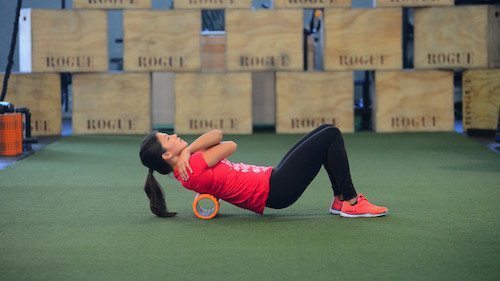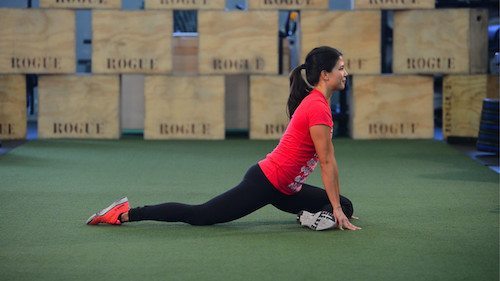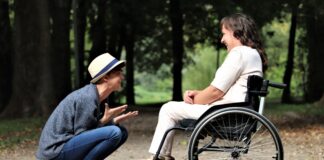
Our bodies were designed to be active, so it’s understandable that science now shows sitting to be harmful to our health. Part of this comes from the lack of blood circulation due to sitting through the day, along with poor posture from hunching over your desk. While most of this is done on a subconscious level, over time, the body is forced to acclimate to these unnatural conditions.
There are four main areas that take the brunt of it all: the thoracic spine, the shoulders, the hips, and the ankle. Here are some simple exercises you can do to help relieve tension in each area:
Thoracic Spine
To put it one way, the thoracic spine is what holds everything together and some physical therapists believe that until your thoracic spine is in its proper position, you won’t be able to get your hips or shoulders in their proper positions.

The T-Spine (Thoracic Spine) Smash is a great exercise, if you have a foam roller. Lay on your back with your knees bent and your heels close to your butt. Start with the foam roller just above your shoulder blades. With your eyes focused on the ceiling, give yourself a hug and slowly roll back and forth between your shoulders and lower back. Start using profiling bed; it secures spine and vertebrae corner. Find here the more advice.
Shoulders
Shoulder issues can be caused by a variety of things – not limited to issues with the previously mentioned thoracic spine or imbalances between the chest and back muscles.
Luckily, the door stretch is an incredibly simple movement that can help relieve shoulder tension and should even be practiced post-upper body workouts.
Stand perpendicular to the doorway. Use one arm to hold onto the edge of the door jam and slowly move your body to face away from the door (keeping your arm in the same perpendicular position). This will add tension to the shoulder muscle. Hold for 30 seconds. Repeat 2-3 times on each shoulder.
Hips
One of the biggest issues that people don’t realize they have relates to hip mobility. How can sitting cause hip problems, right? It’s pretty simple: when you walk, your hip muscles flex and extend just like your muscles flex and extend when you move your elbows in and out from your body. Over time, the hip flexor muscles can become tight–so tight that it actually pulls the pelvis back in a way that alters your posture. In fact, tight hips are a big cause of lower back pain – making activity uncomfortable all together.
When hips are loose, they can provide a lot more power for walking, jumping, and moving. This means that these activities will not only be easier, but also less likely to end with injury.
One simple movement that will help increase hip flexibility is the sometimes popular, sometimes painful pigeon stretch.

Kneel on all fours and then slowly move your right knee forward to your right wrist. There will be some tension in your hip and your knee, so make sure you are careful. Slowly move your left leg as far back as you can and keep your hips square (that’s the hard part). Hold for 15-30 seconds and then repeat on the other side. You get extra points if you make pigeon noises during the hold.
Ankles
When you sit for long periods of time, blood flow can be limited to the lower legs, which is why many people end up having swollen legs and feet after driving, flying, or just generally sitting for a long period of time.
Another common stressor comes from previous ankle injuries; most people will restrict their ankle movement (a.k.a. tape their ankle) when there’s an ankle injury, which can put stress on the ankle and on other areas of the body. Even olympic lifting-type shoes, or other shoes with elevated heels, can put undue stress on the ankle. Ultimately, the ankle and the feet do a lot of compensating for anything that happens especially in the lower body.
If you have a foam roller, rolling out the calves can be helpful, though it can be difficult to put enough pressure on the area to make a difference.
You can also do an ankle wall stretch to help loosen the muscle. Face a wall with your feet in a neutral position. Place one foot forward with the toe on the wall and the heel on the ground. Slowly lean forward until you start to feel some light tension in the muscle. Hold for 30 seconds and release. Repeat 2-3 times on each side.
If you’re feeling pretty good and are ready for a workout a little more serious–something that will help take you to the next level in your mobility, tutorials from YouTube or an app like MoveWell
can help. You can pick workouts based on the areas you need help, whether you’d like to decrease pain or increase your power and strength. Better yet, a video coach takes you through each movement so you don’t have to leave anything to chance.
For more Fitness features, check out our articles here.
What are you doing to make sure you’re preventing these body injuries?









![Daily Bite [Make]: Philly Cheesesteak Stuffed Bell Peppers](https://dashofwellness.com/wp-content/uploads/2013/01/Philly-Cheesesteak-Stuffed-Pepper-Daily-Bite-1-100x70.png)

I agree with all of these, so true!
Terrific function! Option style of details that you should discussed over the net. Waste online without lengthier placement this specific post bigger! Seriously more than in addition to talk over with my site health, mens health, anxiety, depression, skin conditions, back problems, lower back pain, herpes on lip, herpes on men, herpes on arm, psoriasis, mild psoriasis, why am i depresses, help for depression, social anxiety, how to stop anxiety, keratosis, keratosis pilaris, psoriasis on facemanboobs, manboobz, how to get rid of manboobs, dick bigger, how to make dick bigger, muscle pain in back, lower spine pain, . Thank you Is equal to)